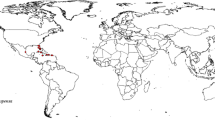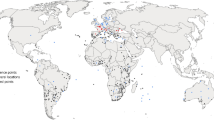Abstract
Climate change is a major factor driving shifts in the distribution of invasive pests. The oriental fruit fly, Bactrocera dorsalis, native to mainland Asia, has spread throughout Southeast Asia and sub-Saharan Africa. Recently, the species has extended its Asian range northward into regions previously thought unsuitable which presents a major new risk to temperate zone agriculture and has invaded Italy. Thus, it is necessary to study how climate change may impact on the global distribution of B. dorsalis. MaxEnt models were used to map suitable habitat for this species under current and future climate conditions averaged from four global climate models under two representative emission pathways in 2050 and 2070. The results highlighted that a total of 30.84% of the world’s land mass is currently climatically suitable including parts of the western coast and southeast of the USA, most of Latin America, parts of Mediterranean coastal European regions, northern and coastal Australia, and the north island of New Zealand. Under future climate conditions, the risk area of B. dorsalis in the northern hemisphere was projected to expand northward, while in the southern hemisphere, it would be southward, especially by 2070 under RCP85 with very high greenhouse gas emissions. Future management of this pest should consider the impacts of the global climate change on its potential geographical distribution.




Similar content being viewed by others
References
Barry S, Elith J (2006) Error and uncertainty in habitat models. J Appl Ecol 43:413–423
Bosso L, Febbraro MD, Cristinzio G, Zoina A, Russo D (2016) Shedding light on the effects of climate change on the potential distribution of Xylella fastidiosa in the Mediterranean basin. Biol Invasions 18:1759–1768
Cantrell B, Chadwick B, Cahill A (2002) Fruit fly fighters: eradication of the papaya fruit fly. CSIRO Publishing, Collingwood, Australia
Chen Y, Vasseur L, You M (2017) Potential distribution of the invasive loblolly pine mealybug, Oracella acuta (Hemiptera: Pseudococcidae), in Asia under future climate change scenarios. Clim Chang 141:719–732
Clarke AR, Armstrong KF, Carmichael AE, Milne JR, Raghu S, Roderick GK, Yeates DK (2005) Invasive phytophagous pests arising through a recent tropical evolutionary radiation: the Bactrocera dorsalis complex of fruit flies. Annu Rev Entomol 50:293–319
Davis MA (2009) Invasion biology. Oxford University Press, Oxford
De Meyer M, Robertson MP, Mansell MW, Ekesi S, Tsuruta K, Mwaiko W, Vayssières J-F, Peterson AT (2010) Ecological niche and potential geographic distribution of the invasive fruit fly Bactrocera invadens (Diptera, Tephritidae). B Entomol Res 100:35–48
De Villiers M, Hattingh V, Kriticos DJ et al (2016) The potential distribution of Bactrocera dorsalis: considering phenology and irrigation patterns. B Entomol Res 106:19–33
Dominiak BC, Mapson R (2017) Revised distribution of Bactrocera tryoni in eastern Australia and effect on possible incursions of Mediterranean fruit fly: development of Australia's eastern trading block. J Econ Entomol 110:2459–2465
Ekesi S, De Meyer M, Mohamed SA, Massimiliano M, Borgemeister C (2016) Taxonomy, ecology, and management of native and exotic fruit fly species in Africa. Annu Rev Entomol 61:219–238
Elith J, Graham CH, Anderson RP et al (2006) Novel methods improve prediction of species’ distributions from occurrence data. Ecography 29:129–151
Elith J, Phillips SJ, Hastie T, Dudík M, Chee YE, Yates CJ (2011) A statistical explanation of MaxEnt for ecologists. Divers Distrib 17:43–57
FAO (2014) http://www.fao.org/news/story/en/item/262972/icode/ Accessed 28 Oct 1999
Fu L, Li ZH, Huang GS, Wu XX, Ni WL, Qü WW (2014) The current and future potential geographic range of West Indian fruit fly, Anastrepha obliqua (Diptera: Tephritidae). Insect Sci 21:234–244
Han P, Wang C, Niu CY, Dong YC, Zhu JQ, Desneux N (2011) Population dynamics, phenology, and overwintering of Bactrocera dorsalis (Diptera: Tephritidae) in Hubei Province, China. J Pest Sci 84:289–295
Hernandez PA, Graham CH, Master LL, Albert DL (2006) The effect of sample size and species characteristics on performance of different species distribution modeling methods. Ecography 5:773–785
Hijmans RJ, Cameron SE, Parra JL, Jones PG, Jarvis A (2005) Very high resolution interpolated climate surfaces for global land areas. Int J Climatol 25:1965–1978
Hill MP, Terblanche JS (2014) Niche overlap of congeneric invaders supports a single-species hypothesis and provides insight into future invasion risk: implications for global management of the Bactrocera dorsalis complex. PLoS One 9:e90121
Hughes L (2000) Biological consequences of global warming: is the signal already apparent? Trends Ecol Evol 15:56–61
Hulme PE (2009) Trade, transport and trouble: managing invasive species pathways in an era of globalization. J Appl Ecol 46:10–18
Hulme PE (2017) Climate change and biological invasions: evidence, expectations, and response options. Biol Rev 92:1297–1313
IPCC (2014) Climate Change 2014: Synthesis Report. Contribution of Working Groups I, II and III to the Fifth Assessment Report of the Intergovernmental Panel on Climate Change [Core Writing Team, R.K. Pachauri and L.A. Meyer (eds.)]. IPCC, Geneva, Switzerland, 151 pp
Kriticos DJ, Maywald GF, Yonow T, Zurcher EJ, Herrmann NI, Sutherst RW (2015) CLIMEX Version 4: exploring the effects of climate on plants, animals and diseases. CSIRO, Canberra
Mack RN, Simberloff D, Mark Lonsdale W, Evans H, Clout M, Bazzaz FA (2000) Biotic invasions: causes, epidemiology, global consequences, and control. Ecol Appl 10:689–710
Manrakhan A, Venter JH, Hattingh V (2015) The progressive invasion of Bactrocera dorsalis (Diptera: Tephritidae) in South Africa. Biol Invasions 17:2803–2809
Merow C, Smith MJ, Silander JA (2013) A practical guide to MaxEnt for modeling species’ distributions: what it does, and why inputs and settings matter. Ecography 36:1058–1069
Nugnes F, Russo E, Viggiani G et al (2018) First record of an invasive fruit fly belonging to Bactrocera dorsalis complex (Diptera: Tephritidae) in Europe. Insects 9:182
Papadopoulos NT, Plant RE, Carey JR (2013) From trickle to flood: the large-scale, cryptic invasion of California by tropical fruit flies. P Roy Soc B-Biol Sci 280:20131466
Pearce J, Ferrier S (2000) An evaluation of alternative algorithms for fitting species distribution models using logistic regression. Ecol Model 128:127–147
Phillips SJ, Anderson RP, Schapire RE (2006) Maximum entropy modeling of species geographic distributions. Ecol Model 190:231–259
Qin Y, Krosch MN, Schutze MK et al (2018) Population structure of a global agricultural invasive pest, Bactrocera dorsalis (Diptera: Tephritidae). Evol Appl 11:1990–2003
Schutze MK, Aketarawong N, Amornsak W et al (2015) Synonymization of key pest species within the Bactrocera dorsalis species complex (Diptera: Tephritidae): taxonomic changes based on a review of 20 years of integrative morphological, molecular, cytogenetic, behavioural, and chemoecological data. Syst Entomol 40:456–471
Stephens AEA, Kriticos DJ, Leriche A (2007) The current and future potential geographical distribution of the oriental fruit fly, Bactrocera dorsalis (Diptera: Tephritidae). B Entomol Res 97:369–378
Sultana S, Baumgartner JB, Dominiak BC, Royer JE, Beaumont LJ (2017) Potential impacts of climate change on habitat suitability for the Queensland fruit fly. Sci Rep 7:13025
Swets JA (1988) Measuring the accuracy of diagnostic systems. Science 240:1285
Vargas RI, Piñero JC, Leblanc L (2015) An overview of pest species of Bactrocera fruit flies (Diptera: Tephritidae) and the integration of biopesticides with other biological approaches for their management with a focus on the Pacific Region. Insects 6:297–318
Wang XJ (1996) The fruit flies (Diptera: Tephritidate) of the East Asian Region. Acta Zootaxon Sin 21:53 in Chinese
Wang SQ, Xiang ZJ, Liu YM, Peng LC, Du G, Zhu CB (2009) The risk analysis of the oriental fruit fly, Bactrocera dorsalis, in Hubei. Plant Protection of Hubei 3:5–6 in Chinese with an English abstract
Wang C, Hawthorne D, Qin YJ, Pan XB, Li ZH, Zhu SF (2017) Impact of climate and host availability on future distribution of Colorado potato beetle. Sci Rep 7:4489
Warszawski L, Frieler K, Huber V et al (2014) The inter-sectoral impact model intercomparison project (ISI–MIP): project framework. P Natl A Sci 111:3228–3232
Wei J, Zhao Q, Zhao W, Zhang H (2018) Predicting the potential distributions of the invasive cycad scale Aulacaspis yasumatsui (Hemiptera: Diaspididae) under different climate change scenarios and the implications for management. PeerJ 6:e4832
Yackulic CB, Chandler R, Zipkin EF et al (2013) Presence-only modelling using MAXENT: when can we trust the inferences? Methods Ecol Evol 4:236–243
Young N, Carter L, Evangelista PA (2011) MaxEnt model v3.3.3e tutorial (ArcGIS v10). Fort Collins, Colorado
Yuan M, Wang B, Song CB, Rong XL, Yin Y (2008) Effect of climate factors and host plants on population dynamics of Bactrocera dorsalis (Hendel) in Suzhou. J Anhui Agric Sci 22:9619–9621 in Chinese with an English abstract
Zeng Y, Reddy GVP, Li ZH et al (2019) Global distribution and invasion pattern of oriental fruit fly, Bactrocera dorsalis (Diptera: Tephritidae). J App Entomol 143:165–176
Acknowledgments
The authors would like to thank all members of the Plant Quarantine and Invasion Biology Laboratory of China Agricultural University (CAUPQL). We are grateful to the anonymous reviewers and editors for their pertinent and professional comments.
Funding
This study was supported by the National Key Research Project (2018YFF0214905).
Author information
Authors and Affiliations
Corresponding author
Additional information
Publisher’s note
Springer Nature remains neutral with regard to jurisdictional claims in published maps and institutional affiliations.
Electronic supplementary material
ESM 1
(DOCX 2155 kb)
Rights and permissions
About this article
Cite this article
Qin, Y., Wang, C., Zhao, Z. et al. Climate change impacts on the global potential geographical distribution of the agricultural invasive pest, Bactrocera dorsalis (Hendel) (Diptera: Tephritidae). Climatic Change 155, 145–156 (2019). https://doi.org/10.1007/s10584-019-02460-3
Received:
Accepted:
Published:
Issue Date:
DOI: https://doi.org/10.1007/s10584-019-02460-3




